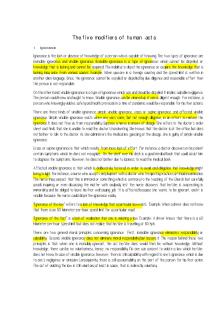\"The fusion of law and equity\" Th 1873-75 Judicature Acts PDF

| Title | \"The fusion of law and equity\" Th 1873-75 Judicature Acts |
|---|---|
| Course | Equitable Remedies |
| Institution | The University of the West Indies Cave Hill Campus |
| Pages | 2 |
| File Size | 91.3 KB |
| File Type | |
| Total Downloads | 71 |
| Total Views | 116 |
Summary
Hope this helps in any way that it can....
Description
The fusion of law and equity The Judicature Act 1873-1875 Prior to the 1873 to 1875 Judicature Act but after the Earl of Oxford’s case, equity was sought to be moving away from a body of law that was extemporaneous and unpredictable, to a set of rules that were becoming rigid. Even to the extent that, chancellors began to renounce the Courts of chancellery, as being a court of conscience and declared precedent supreme. This can be seen in the cases such as Re National Funds Assurance Co (1878) 10 ChD 118 where the Chancery Division of the High Court was declared a court of Law and not conscience. The Court of Chancery Act 1850 and the Court of Chancery Procedure Act 1852 were early attempts to wrestle with the procedural problems in the Court of Chancery. However, it wasn’t until the 1873-1875 Judicature Acts that a major advancement was made as to expediting the procedure of the chancery. NB: it was due to administrative delays that the Act was postponed until 1875 when it was instituted with amendments. The coming of the 1873-1875 Judicature Act established in England one single Supreme Court of Judicature which by Section 3 of this said act consolidated and unified the old Court of Chancery with the courts of common law. For instance, the court of Common Pleas at Westminster, the Court of Exchequer, the High Court of Chancery in England and Court of the Queen’s Bench. It also split that Supreme court into the High Court and the Court of Appeal. However, what did the Judicature Act exactly do? This question has troubled many scholars and lead to debates over whether the occasioning of this nineteenth century Act fused the rules of equity and common law so that they became one or merely combined both the rules of equity and common law in a sense so that the rules still retain their individual identity but are administered by a single court? In layman terms, one half of the argument is that it doesn’t make sense to distinguish between the rules of equity and common law since both courts are now fused by the Judicature Act whilst the on the other hand, other learned professionals believe the fusion is strictly procedural so that only the administrations are fused and not the rules since Section s.49 of the now “fused” Supreme Court Act makes the distinction that wherever equity and common law conflicts, equity prevails.
On the one hand of the debate, where we see claims being made that the Judicature act only fused the administration of equity and common law and not the rules as they still, after the coming of the act, retained their individual identities. The judgments brought about in Salt v cooper supports this side of coin where Jessel MR propounds that the main object of the Act was to assimilate the transaction of Equity business and Common Law business by different Courts of Judicature. Thus, supporting this school of thought. On the other hand, this fusion is seen as procedural and not just administrative and the coming of the Judicature act (1873-1875) not only fused the jurisdiction of the courts but the also fused the rules to which each court, prior to the act enforced separately, so that now they are regarded as one. Learned scholars have cemented this view in their judicial judgments. For example, In Errington v Errington lord denning stated that “equity and the law have been fused for nearly eighty years now” and his Lordship in Boyer v Warbey declared that with the coming of the procedural fusions of law the distinction of the doctrine of covenants only running with the land only applied to covenants under seal and not agreements under hand were obliterated....
Similar Free PDFs

The Fusion of Law and Equity
- 4 Pages

Equity ACTS IN Personam
- 1 Pages

Equity Acts in Personam
- 6 Pages

Maxims of Equity Equity Law
- 5 Pages

reception of law of equity
- 10 Pages

Equity under the Malaysian Law
- 18 Pages

Equity LAW
- 48 Pages

Prominent Cases & Acts (BIZ LAW)
- 8 Pages

Common Law and Equity Notes
- 8 Pages

Equity and the Doctrine of Notice
- 22 Pages

The five modifiers of human acts
- 3 Pages
Popular Institutions
- Tinajero National High School - Annex
- Politeknik Caltex Riau
- Yokohama City University
- SGT University
- University of Al-Qadisiyah
- Divine Word College of Vigan
- Techniek College Rotterdam
- Universidade de Santiago
- Universiti Teknologi MARA Cawangan Johor Kampus Pasir Gudang
- Poltekkes Kemenkes Yogyakarta
- Baguio City National High School
- Colegio san marcos
- preparatoria uno
- Centro de Bachillerato Tecnológico Industrial y de Servicios No. 107
- Dalian Maritime University
- Quang Trung Secondary School
- Colegio Tecnológico en Informática
- Corporación Regional de Educación Superior
- Grupo CEDVA
- Dar Al Uloom University
- Centro de Estudios Preuniversitarios de la Universidad Nacional de Ingeniería
- 上智大学
- Aakash International School, Nuna Majara
- San Felipe Neri Catholic School
- Kang Chiao International School - New Taipei City
- Misamis Occidental National High School
- Institución Educativa Escuela Normal Juan Ladrilleros
- Kolehiyo ng Pantukan
- Batanes State College
- Instituto Continental
- Sekolah Menengah Kejuruan Kesehatan Kaltara (Tarakan)
- Colegio de La Inmaculada Concepcion - Cebu




